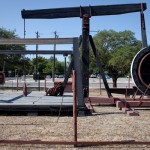The Pipeline vs. the Farmer: What Happens Next for Keystone XL in Texas

Photo by Flickr user Stuck in Customs/Creative Commons
Pipeline companies are finding themselves with a new obstacle: defenders of private property rights.
There’s a showdown taking place over a fifty-foot wide swath of farmland in northeast Texas, and the outcome could have a significant effect on the future of the Keystone XL pipeline and how it’s perceived by the public.
As we reported last week, the company behind the pipeline, TransCanada, has won an eminent domain claim to route the pipeline through the farmland of Julia Trigg Crawford, who decided not to allow the company to construct the pipeline through her land. While Crawford is appealing that eminent domain claim, she has also filed a temprorary restraining order against TransCanada that for the time being bars them from entering her property. Now TransCanada is asking for that restraining order to be dissolved.
On Friday, a district judge in Lamar County held a hearing on Crawford’s restraining order. Both sides had their say in a session that started at nine and didn’t end until three in the afternoon. “It was a crazy, crazy wild day,” Crawford says. The company says Crawford and her attorneys “violated state law by seeking a temporary restraining order without our knowledge,” according to a statement by the company. The judge will make a ruling on whether or not to dissolve the temprorary restraining order sometime this week.
While much of the opposition to the Keystone XL pipeline has come from environmental corners, the case of the pipeline versus the farmer illustrates a new obstacle for the company: defenders of private property rights.
The case of Crawford has been trumpeted by Tea Partiers, Libertarians and left-leaning environmentalists alike, who challenge TransCanada’s use of eminent domain to construct the pipeline on private land.
The company says eminent domain is justified because the Keystone XL is a “common carrier” pipeline. While eminent domain is typically used for public projects, in this case the private company argued that since the oil passing through the pipeline would ultimately be used by the public. They argue the pipeline is a public “common carrier” one and not a private pipeline, even though it’s privately owned and operated.
TransCanada says they use eminent domain only “when landowners refuse to communicate or negotiate with us or leave us with no other way to reach an easement agreement,” according to a statement from the company. They also say they’ve made agreements with “nearly 99 percent of land tracts in Texas” where they wish to route the pipeline.
Crawford, on the other hand, says her reasons for opposing the pipeline are personal, not political. “One of my first concerns was, to go the path they had planned, they had to horizontally drill under the creek that I have water rights to,” Crawford told StateImpact Texas. “So, I didn’t exactly want this sludge being pumped underneath the creek.” Crawford also said that if the pipeline was buried underneath her property it could create a “vegetative dead zone” for her crops, because the temperature of the line can get up to 140 degrees.
“I’m at least safe for a few more days,” Crawford says. She believes the company intends to start construction as soon as March 1st. TransCanada says that is not their plan, and that there’s “no impending construction on this property or any other property, for that matter,” according to a statement from the company.
As for Crawford’s appeal of the condemnation of her property under eminent domain, there will be a trial on April 30th in the same court.


